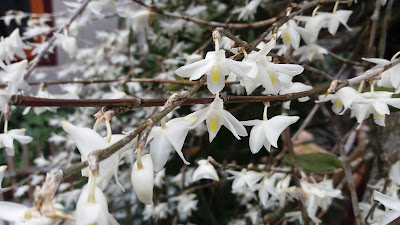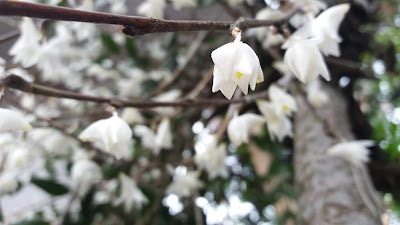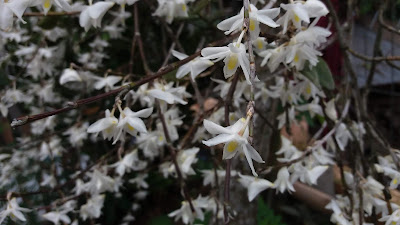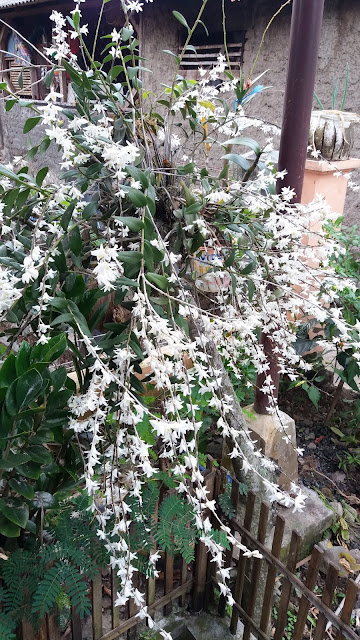Classification
Kingdom
|
:
Plantae – Plantae
|
Subkingdom
|
:
Tracheobionta – Vascular plants
|
Division
|
:
Magnoliophyta – Flowering plants
|
Subdivision
|
:
Angiospermae – Seed encloses plants
|
Class
|
:
Magnoliopsida – Dicotyledons
|
Order
|
:
Asparagales
|
Family
|
:
Orchidaceae - Orchid
|
Genus
|
:
Dendrobium
|
Species
|
: Dendrobium crumenatum Sw., 1799
|
Synonym(s)
Mokara crumenatum, Epidendrum canium, Aporum crumenatum, Mokara crumenata, Dendrobium kwashotense (NPark Singapore, -).
Popular Name(s)
- Local name(s): Anggrek Melati
- Common name(s): Pigeon Orchid (English), White Dove Orchid, Pigeon Flower, Sparrow Orchid, Bag-shaped Dendrobium, Daun Seputih Tulang (NPark Singapore, -), Anggrek Merpati (Indonesian),
Type:
shrubby, shrub (Herbaceous; trailing), epiphyte, perennial
Habitat & Microhabitat
Old
trees in open country (Meesawat and Kanchanapoom, 2007). It's found on L. leucocephala.
Flower
Life Span on Plant
One day,
and it was very fragrant. It's the reason why Sundanese called this orchid "Anggrek Melati"(Sundanese; Anggrek=orchid, Melati=Jasmine) because of the flower white and fragrant such as Jasmine flower. Recorded: bloom on 3rd July 2018 in Bandung, 4th
July 2018 in Sumedang. It's blooming again on 18th August 2018.
Distribution
South China, Indochina, Burma, Malay Peninsular, The Philippines to South-East Asia, Indonesia, New Guinea (Meesawat and
Kanchanapoom, 2007), Christmas Island, Fiji, Hawaii. It’s reported for the first
time from the mainland of India (Andaman dan the Nicobar Islands, now in Kerala)
(Ram et al., 2015).
Treatment
There
are a lot of tutorial about it. But honestly, what my family did was to use
coconut fibbers planting medium and put it in enough light (full sun), and the last to
water it with rice washing water.
Utilization
Medicine as ethnobiology (Nuriliani, et al.,
interviewed on Jitunews, 2016) in China of one genus Dendrobium, D.
catenatum is used to treat rheumatism (Wiart, 2014) and ornament
plant.
Pharmacology
Antioxidant, phenol, flavonoids (Topriyani, 2013).
Toxicity
-
Pictures
Picture 1. Dendrobium crumenatum, located Buahdua, Sumedang (4th July 2018)
Picture 2. Dendrobium crumenatum, located Buahdua, Sumedang
Picture 3. Dendrobium crumenatum, located Buahdua, Sumedang
Picture 4. Dendrobium crumenatum, located Buahdua, Sumedang
Picture 5. Dendrobium crumenatum, located Buahdua, Sumedang
- EOL. Accessed on 05-07-2018.
- Jitunews. 2016. Potensi Antikangker Anggrek Merpati. Accessed on 05-07-2018.
- Meesawat, U and Kamoon Kanchanapoom. 2017. Understanding the Flowering Behavior of Pigeon Orchid (Dendrobium crumenatum Swartz). Orchid Science and Biotechnology: Global Science Books I(I),6-14.
- National Park. Accessed on 05-07-2018.
- Ram, A. T., Shamina, M., and A. K. Preadeep. 2015. Dendrobium crumenatum (Orchidaceae): A new record for mainland India. Rheedea: Vol 25(1): 69-71.
- Topryani, Riski. 2013. Aktivitas antioksidan dan karakter antaomi vegetatif Anggrek Merpati (Dendrobium crumenatum Sw.). Yogyakarta : Universitas Gajah Mada.
- Wiart, Christhope. 2014. Lead Compounds from Medical Plant for The Treatment of Neurodegenerative Diseases.





Comments
Post a Comment